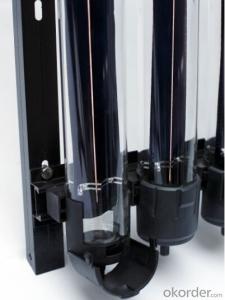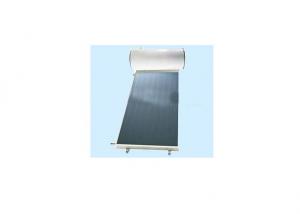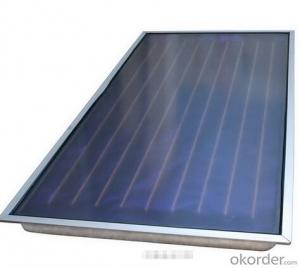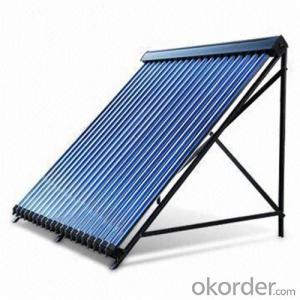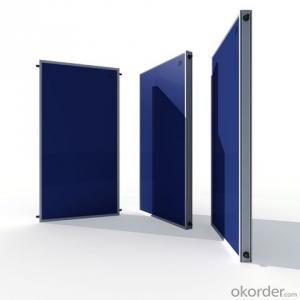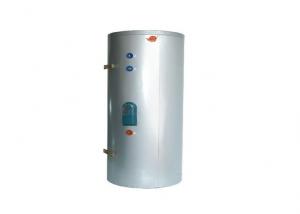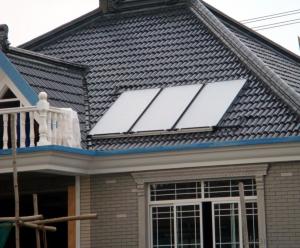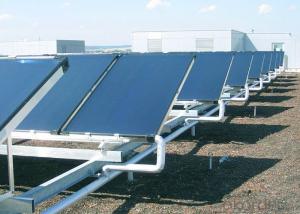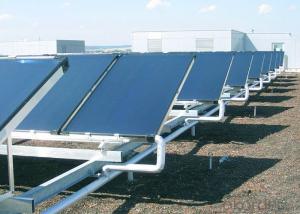Metal Glass Heat Pipe for Solar Collector Model SC-HM
- Loading Port:
- Shanghai
- Payment Terms:
- TT OR LC
- Min Order Qty:
- 20 set
- Supply Capability:
- 1500 set/month
OKorder Service Pledge
OKorder Financial Service
You Might Also Like
1. Structure of Metal Glass Heat Pipe for Solar Collector Model SC-HM
This Metal Glass Heat Pipe is an important part for solar collector, and the components are following as shown with graphic:

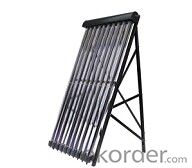
1 Manifold
2 Inlet & Outlet
3 Bracket
4 Metal Glass Vacuum Tube
5 Pipe Supporter
6 Anti-wind Foot
2. Main Features of Metal Glass Heat Pipe for Solar Collector Model SC-HM
The Metal glass vacuum tube is sealed together, high temperature, anti-freezing, insulation with vacuum.
Withφ70 vacuum tube, large collecting area, strong heat collecting efficiency, high temp, rapid heat conducting.
Aluminum alloy manifold & bracket weight less, the surface has treatment of oxidation. It can withstand corrosion resistance.
The super thick insulation layer is Molded rock wool/mineral wool, with high density & low coefficient of heat conductivity
The flow chute is made of high quality brass, with pressure and corrosion resistance, high purity and can withstand 1MPa pressure.
Adjustable pipe supporter and easy for installation.
3. Metal Glass Heat Pipe for Solar Collector Model SC-HM Images
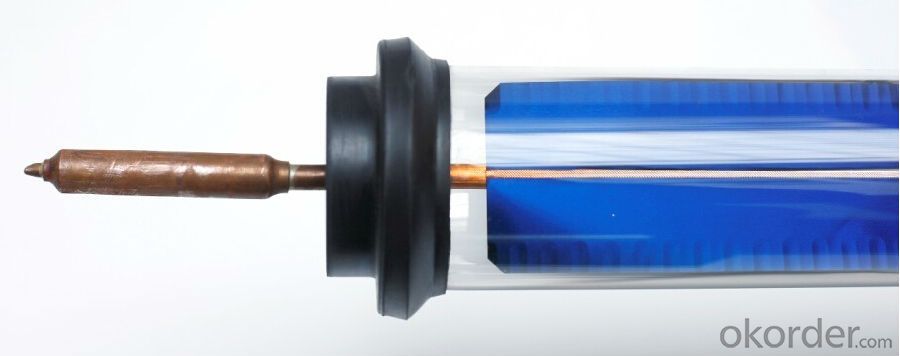
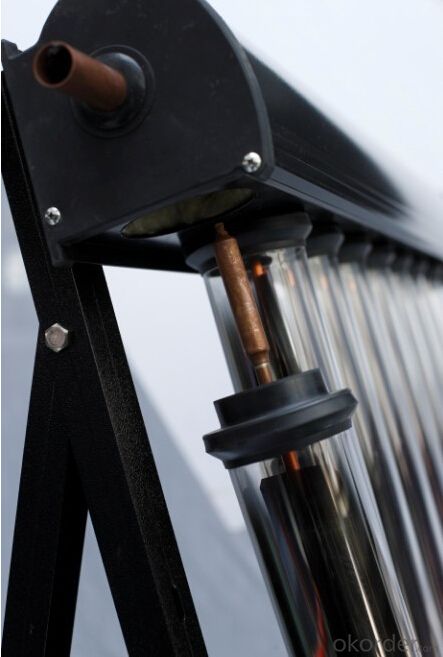
4. Metal Glass Heat Pipe for Solar Collector Model SC-HM Specifications
Model No. | SC-HM-10 | SC-HM-15 | SC-HM-18 | SC-HM-20 | SC-HM-24 | SC-HM-25 | SC-HM-30 |
No.of Vacuum Tube(PCS) | 10 | 15 | 18 | 20 | 24 | 25 | 30 |
Tube Space(㎜) | 100 | 100 | 100 | 100 | 100 | 100 | 100 |
OD/L of Vacuum Tube(㎜) | φ70/2000 | φ70/2000 | φ70/2000 | φ70/2000 | φ70/2000 | φ70/2000 | φ70/2000 |
Material of Vacuum Tube | Borosilicate glass 3.3 | Borosilicate glass 3.3 | Borosilicate glass 3.3 | Borosilicate glass 3.3 | Borosilicate glass 3.3 | Borosilicate glass 3.3 | Borosilicate glass 3.3 |
Material/Thickness of Heat Pipe(㎜) | Coppertp2/0.6 | Coppertp2/0.6 | Coppertp2/0.6 | Coppertp2/0.6 | Coppertp2/0.6 | Coppertp2/0.6 | Coppertp2/0.6 |
OD/Thickness of Flow Chute(㎜) | φ35/1.0 | φ35/1.0 | φ35/1.0 | φ35/1.0 | φ35/1.0 | φ35/1.0 | φ35/1.0 |
OD of Outlet & Inlet | φ22 or 3/4″ | φ22 or 3/4″ | φ22 or 3/4″ | φ22 or 3/4″ | φ22 or 3/4″ | φ22 or 3/4″ | φ22 or 3/4″ |
Insulation Material/Thickness(㎜) | Rockwool/40 | Rockwool/40 | Rockwool/40 | Rockwool/40 | Rockwool/40 | Rockwool/40 | Rockwool/40 |
Working Pressure(MPa) | 0.6 | 0.6 | 0.6 | 0.6 | 0.6 | 0.6 | 0.6 |
Working Temp ℃ | <150 | <150 | <150 | <150 | <150 | <150 | <150 |
Capacity of Solar Collector(L) | 0.69 | 0.98 | 1.15 | 1.27 | 1.50 | 1.56 | 1.85 |
Collecting Area(㎡) | 1.37 | 2.05 | 2.46 | 2.73 | 3.28 | 3.41 | 4.10 |
Total Area(㎡) | 2.20 | 3.28 | 3.92 | 4.35 | 5.21 | 5.43 | 6.50 |
Flow Rate(L/min) | 1.06 | 1.49 | 1.79 | 2.0 | 2.4 | 2.5 | 3.0 |
drop of pressure (Pa) | 16.24 | 41.4 | 63.4 | 81.7 | 127.2 | 140.1 | 219.8 |
Intercept efficiency η0 | 0.77 | 0.77 | 0.77 | 0.77 | 0.77 | 0.77 | 0.77 |
Heat loss rate a W/㎡℃ | 1.9 | 1.9 | 1.9 | 1.9 | 1.9 | 1.9 | 1.9 |
Efficiency(W)1000W/㎡irradiation | 744 | 1044 | 1256 | 1398 | 1681 | 1748 | 2098 |
N.W(kg) | 40.25 | 52.75 | 61.75 | 66.75 | 81.00 | 85.35 | 100.70 |
a (㎜) | 1115 | 1615 | 1915 | 2115 | 2515 | 2615 | 3115 |
b (㎜) | 1025 | 1525 | 1825 | 2025 | 2425 | 2525 | 3025 |
c (㎜) | 950 | 1450 | 1750 | 1950 | 2350 | 2450 | 2950 |
c/2 (㎜) | —— | —— | 875 | 975 | 1175 | 1225 | 1475 |
d (㎜) | 2150 | 2150 | 2150 | 2150 | 2150 | 2150 | 2150 |
e (㎜) | 1375 | 1240 | 1240 | 1240 | 1240 | 1240 | 1240 |
f (㎜) | 1590 | 1590 | 1590 | 1590 | 1590 | 1590 | 1590 |
5. FAQ
1. What happens if one of the solar tubes is broken?
Firstly, tubes are very strong and not easily broken, but if the worst should happen, solar tubes can be replaced very easily. They are inexpensive and available. The solar collectors can operate with several broken tubes, but the efficiency will be reduced, so it is recommended that broken tubes be replaced immediately.
2. Can the solar collectors be mounted on a flat surface?
Yes they may be mounted on a flat roof or on the ground by using a stainless steel Flat Roof Frame. The collector should be installed at a minimum of 20o angle to ensure optimal operation of the heat pipe.
3. Will the solar collector be a fire hazard during hot, dry weather?
No. The solar collector's components are all high temperature rated and non-flammable, so even during strong sunlight with the circulation pump turned off (stagnation), the system will not catch alight or give off any sparks. The majority of the solar collector's components are stainless steel, aluminium, glass or glass wool. The manifold outlet should be fitted with a temperature relief valve, which will prevent the manifold temperature from exceeding 99oC / 212oF.
- Q:How do solar collectors compare to geothermal heating systems in terms of efficiency?
- Solar collectors and geothermal heating systems both provide efficient heating solutions, but their efficiency levels vary. Solar collectors harness solar energy to heat water or air, making them highly efficient in areas with ample sunlight. On the other hand, geothermal heating systems utilize the stable heat from the earth's core, which makes them efficient in any climate. While solar collectors may be more efficient in terms of capturing renewable energy, geothermal systems offer consistent heating throughout the year. Ultimately, the choice between the two depends on factors such as location, available resources, and specific heating requirements.
- Q:Can solar collectors be used for heating car washes?
- Yes, solar collectors can be used for heating car washes. Solar thermal collectors can harness the energy from the sun to heat water, which can then be used for various purposes, including heating the water used in car washes. This can help reduce energy costs and make car wash operations more environmentally friendly.
- Q:Can solar collectors be used for industrial purposes?
- Yes, solar collectors can be used for industrial purposes. They can provide an efficient and sustainable source of energy for various industrial processes such as heating, cooling, and powering machinery. Solar thermal collectors can effectively harness the sun's energy and convert it into heat, which can be utilized in industrial applications. Additionally, photovoltaic solar collectors can generate electricity that can be used in various industrial operations. The use of solar collectors in industries contributes to reducing reliance on traditional fossil fuel-based energy sources and helps in achieving sustainability goals.
- Q:Can solar collectors be used for heating factories and manufacturing plants?
- Yes, solar collectors can be used for heating factories and manufacturing plants. Solar thermal systems, such as solar water heaters or solar air heaters, can be installed to collect and convert sunlight into usable heat energy. This renewable energy source can help reduce the reliance on traditional fossil fuel-based heating systems, leading to cost savings and a decrease in carbon emissions.
- Q:Can solar collectors be used for heating residential communities?
- Yes, solar collectors can be used for heating residential communities. Solar thermal systems can be installed in residential areas to collect and convert sunlight into usable heat energy. This heat can then be used for space heating and water heating in homes, reducing the reliance on traditional fossil fuel-based heating methods and promoting sustainability.
- Q:Are there any aesthetic considerations with solar collectors?
- Yes, there are aesthetic considerations with solar collectors. The appearance of solar collectors can vary depending on the design, size, and placement. Some people may find them visually intrusive or not aesthetically pleasing, particularly if they are large or mounted on rooftops. Therefore, it is important to consider the visual impact and integration of solar collectors into the overall design and architecture of the surrounding environment.
- Q:Can solar collectors be used in healthcare facilities?
- Yes, solar collectors can be used in healthcare facilities. They can provide a sustainable and renewable source of energy for heating water, powering equipment, and supporting various energy-intensive processes in hospitals and clinics. Solar collectors can help reduce reliance on traditional energy sources, lower operating costs, and contribute to a greener and more environmentally friendly healthcare sector.
- Q:What is the maintenance cost for solar collectors?
- The maintenance cost of solar collectors can vary depending on the type and size of the system, as well as the specific components utilized. Generally, solar collectors have relatively low maintenance costs in comparison to other forms of energy generation. Cleaning the panels is one of the main maintenance tasks for solar collectors, ensuring optimal efficiency. This can be accomplished by using water and a soft cloth or sponge. In certain cases, if the panels are installed at an angle, rainwater may be sufficient for keeping them clean. Regular inspection of the system is also crucial in identifying any issues or damages that may necessitate repairs. This includes checking for loose connections, damaged wiring, or signs of wear and tear. It is recommended to have a professional technician conduct these inspections to ensure safety and proper system functioning. In terms of costs, routine maintenance for solar collectors typically involves minimal expenses. Cleaning supplies like water and cleaning agents may be necessary, but these items are generally inexpensive. If any repairs or replacements are required, such as fixing a broken panel or replacing a faulty component, the cost will depend on the specific problem and the extent of the repair. Overall, although there are some maintenance tasks and potential costs associated with solar collectors, they are generally minimal when compared to the long-term benefits and savings provided by solar energy.
- Q:Can solar collectors be used for generating electricity on wearable devices?
- Yes, solar collectors can be used for generating electricity on wearable devices. With advancements in technology, miniaturized solar panels can now be integrated into wearable devices such as smartwatches, fitness trackers, and even clothing. These solar collectors harness sunlight to convert it into electrical energy, which can then be used to power the device or charge its batteries. This innovative approach helps extend the battery life of wearable devices and reduces the need for frequent charging, making them more convenient and eco-friendly.
- Q:Can solar collectors be used for heating bike paths?
- Yes, solar collectors can be used for heating bike paths. Solar collectors can collect and convert sunlight into heat energy, which can then be used to warm up bike paths during colder seasons. This can help prevent ice formation and enhance safety for cyclists.
1. Manufacturer Overview |
|
|---|---|
| Location | |
| Year Established | |
| Annual Output Value | |
| Main Markets | |
| Company Certifications | |
2. Manufacturer Certificates |
|
|---|---|
| a) Certification Name | |
| Range | |
| Reference | |
| Validity Period | |
3. Manufacturer Capability |
|
|---|---|
| a)Trade Capacity | |
| Nearest Port | |
| Export Percentage | |
| No.of Employees in Trade Department | |
| Language Spoken: | |
| b)Factory Information | |
| Factory Size: | |
| No. of Production Lines | |
| Contract Manufacturing | |
| Product Price Range | |
Send your message to us
Metal Glass Heat Pipe for Solar Collector Model SC-HM
- Loading Port:
- Shanghai
- Payment Terms:
- TT OR LC
- Min Order Qty:
- 20 set
- Supply Capability:
- 1500 set/month
OKorder Service Pledge
OKorder Financial Service
Similar products
New products
Hot products
Hot Searches
Related keywords

